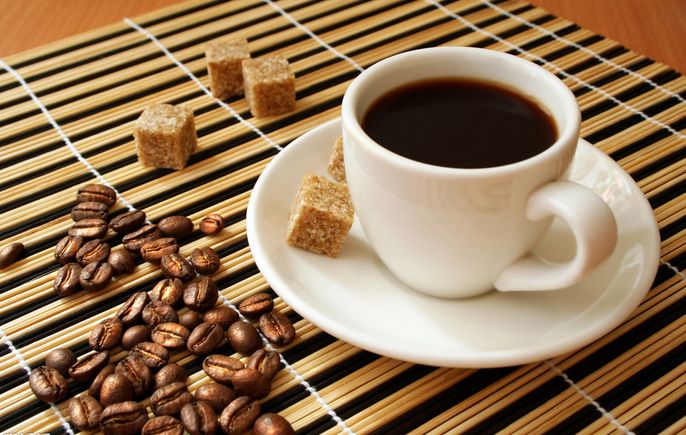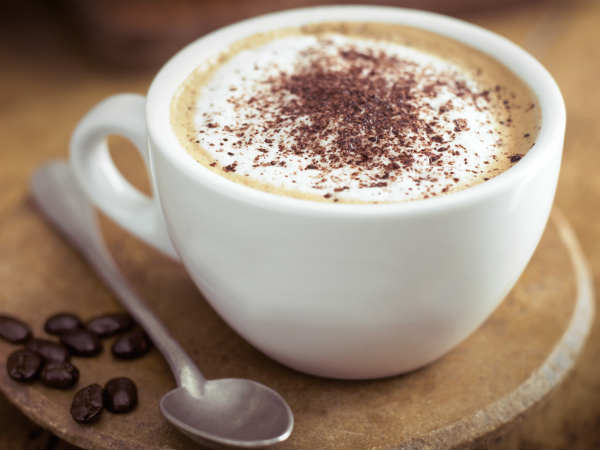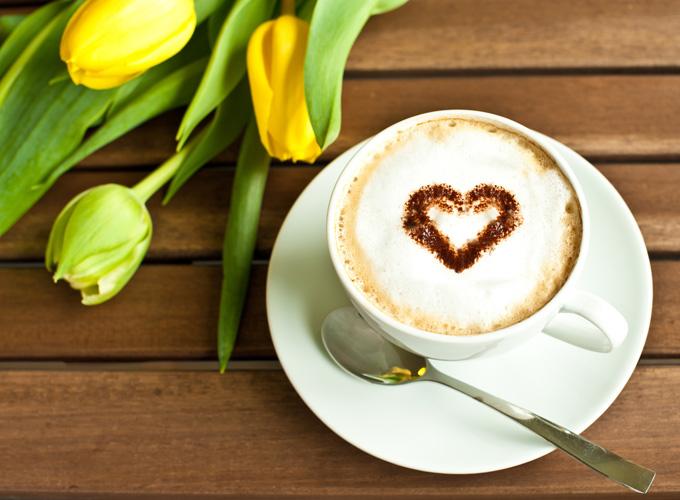What if you can't quit coffee and are sensitive to caffeine?
Although the raw materials are similar: eggs, beans (coffee beans are beans) and flour, those who drink coffee and sandwiches, and those who drink soy milk and eat egg pancakes are probably not likely to be the same.
Drinking coffee sometimes becomes a ritual in the office, with a latte in the morning to warm your stomach, a cup of black coffee to clear your intestines after dinner, and a cup of coffee break; meeting or brainstorming in the afternoon, as if you can't get creative inspiration. Before I knew it, I had already had several cups, and drinking coffee was faster than drinking water.
Coffee is good, but don't drink too much. According to research by the Mayo Medical Center (Mayo Clinic), it is safe for most healthy adults to consume less than 400mg of caffeine a day-about four cups of coffee or two cans of energy drinks.
If you eat too much caffeine, you may have such adverse symptoms: migraine, insomnia, emotional effects (including anxiety, irritability, irritability, restlessness, etc.), polyuria, stomach discomfort, rapid heartbeat, muscle convulsions.
Some people are even more miserable, shaking their hands and sweating after a cup of coffee, which is a sign of sensitivity to caffeine. On the one hand, people who do not consume caffeine regularly are more likely to have this phenomenon; on the other hand, it is also related to genes, health status (physical and psychological), age, medication history and other factors.
According to statistics from American research institutions, about 20% of the population have such a sensitive reaction.
If you are unlucky to have this 20%, or if coffee is a drug you can't quit, not even a cup of coffee, try these ways to help you enjoy your coffee while reducing your caffeine intake as much as possible.

Please unswervingly buy Arabica beans
In the coffee world, there are two main varieties of coffee beans: Arabica and Robusta, whose different planting conditions and flavor characteristics also lead to very different prices and uses.
Arabica bean vs. Robusta bean
Robusta beans contain about twice as much caffeine as Arabica beans, so drinking some bottled coffee is prone to palpitations and insomnia-these mass-produced coffee drinks usually use cheap robusta beans.
If the coffee bean package does not indicate which kind of beans, you can pay attention to the origin:
Africa: Kenya, Ethiopia, Zambia
South America: Cuba, Colombia, Ecuador, Bolivia, Venezuela
North America: Mexico, Guatemala, Puerto Rico, Dominica, Haiti
If the country of origin is in these places, congratulations, it must be Arabica beans, because these areas do not produce robusta beans.
Global coffee producing area distribution
When traveling in Southeast Asia, many people will buy some locally grown coffee, such as Indonesian coffee and Vietnamese coffee. These are all big coffee producing countries, including the Yunnan region of our country, which also produces famous small grains of coffee. But these brushes are Robusta beans with high caffeine content.
Blended coffee beans
Robusta beans have a high yield, less stringent planting conditions than Arabica beans, low production costs and cheap prices, and are often used to match coffee beans to reduce the price of coffee beans, and some Italian coffee beans, even if they are called "boutique". Will also use high-quality Robbata beans, because it is richer in coffee oil. Therefore, try not to buy mixed beans, or pay attention to how to spell them before you buy them.
2DIY your own decaffeinated beans
When it comes to mixed beans, you can DIY yourself to reduce caffeine. Replace 100% Arabica beans with decaffeinated beans. If the flavor of the coffee is more important to you, mix it up at 1:1. If it's more important that decaf doesn't burden the body, mix it up at 1:2.
There is a small skill in blending coffee beans, that is, complementarity: strong and weak, more and less, complex and single. To put it simply, there is no room for two tigers in one mountain.
A perfect cup of coffee is about the balance of aroma (aroma), acidity (acidity), taste (body) and flavor (flavor) (balance). If both are extremely complex and love to steal the limelight, it will only be bitter for coffee drinkers.
Taste a cup of coffee and proceed from these aspects
For example, beans from Kenya, Yemen, Mocha, Sumatra Manning or Guatemala, which are mellow and recognizable, can be paired with mild decaffeinated beans, such as those from Costa Rica or Colombia.
3 try deep-baked beans
Yes, you heard right. Contrary to what most people think, lightly roasted beans are the ones with more caffeine.
For coffee beans of the same volume, the caffeine content is as follows:
Note that I'm talking about volume, not weight.
Why do you say that? This is about what happens to coffee beans during roasting: coffee beans lose moisture (that is, about 20% of their weight) and their volume expands. As a result, coffee beans become lighter and bigger.
Coffee beans in roasting
Deep-baked beans take longer to bake, so it is not difficult to understand that they are lighter in weight and larger in volume than lightly baked beans.
So, when extracting coffee, if you weigh the coffee powder with a spoon, the deep-roasted coffee powder will weigh less at the same volume-and, of course, less caffeine per spoonful.
4 adjust the roughness and fineness of grinding
In the case of the same extraction method, the finer the grinding degree, the more caffeine is released. Therefore, the coffee powder can be ground a little thicker to reduce caffeine.
Coffee powder with different grinding degrees
Of course, don't grind it too hard-unless you want coffee as light as washpot water.
5 pay attention to the extraction time
Sometimes what we take for granted is not necessarily right. For example, you firmly believe that rich Espresso contains more caffeine than other coffees.
In 1979, two American scholars, Bunker and McWilliams, studied the caffeine in coffee with different extraction methods, and published their conclusions in the National Biotechnology Information Center (National Center for Biotechnology Information, referred to as NCBI). The results were unexpected:
In terms of cups, Espresso actually has the lowest caffeine content, with about 100mg of caffeine per cup (about 60 milliliters of 2 ounces).
The second lowest is coffee extracted from a French kettle, which contains about 107.5 milligrams of caffeine per cup (7 ounces of about 205ml).
Instead, the highest is the drip-filtered coffee, which looks "light", with about 145 milligrams of caffeine (about 205 milliliters of 7 ounces) per cup.
To sum up, with the same amount of coffee beans, the longer you extract coffee, the higher the caffeine content. Mom, I don't dare to drink the Vietnamese coffee that I've been waiting for all day.)
Watch the Vietnamese filter coffee drop by drop, you can watch it for a day.
Summer is coming, cold extract coffee is a good choice
Many people like to drink Starbucks' cold coffee, so you should really know that Starbucks uses the Toddy cold coffee system, invented by Todd Simpson, a chemical engineering major from Cornell University, inspired by ancient Peruvian craftsmanship.
The coffee produced by this method contains about 30% less caffeine than hot-extracted drip-filtered coffee. At the same time, the acidity is reduced by 67%, making it less irritating to the stomach.
Of course, you don't have to do such a big thing at home, there are a lot of household cold extraction tools for you. On this point, Yachi (official account ID:caixin-enjoy) once wrote a tweet, "Why is Cold extract Coffee so Hot?", from basic knowledge to individual products, it will certainly help you.
7 there is also natural decaf coffee
There are also some natural decaffeinated varieties in the coffee world, such as Passiona Coffee, launched by Vietnamese coffee giant Zhongyuan Coffee, which is mainly aimed at women, with only 35% of the caffeine content of regular coffee, just like some decaffeinated coffee.
This decaffeinated coffee is made by breeding Chari coffee, which means Liberian Coffee in French and is a coffee variety from the West African country of Libya. Because it is extremely difficult to grow and handle, this kind of coffee accounts for only 1% of global coffee production.
Passiona itself has nutty, chocolate, and slightly fruity aromas, but in terms of flavor, it is not a well-balanced cup of coffee. So, if you are an extremely strict flavor of coffee essence, you can try to match it with a low-caffeinated Arabica bean to increase the richness of the taste.
8 give instant coffee a chance
According to the U.S. Department of Agriculture (United States Department of Agriculture, USDA), 1.8g of instant coffee (about one teaspoon) contains about 15 milligrams of caffeine, about half the amount of drip-filtered coffee.
Instant coffee is in the process of extracting coffee beans, through the method of freeze-drying, extract water, so that the extracted coffee liquid into an instant powder, as soon as hot water can be added into a cup of delicious coffee.
Of course, I know that real coffee lovers are absolutely contemptuous of instant coffee. "it's not coffee, it's all coffee skin, it's all bits and pieces!" But instant coffee is also available in three or six or nine grades, and there is no shortage of instant coffee with 100% Arabica beans on the market, which is worth a try.
Important Notice :
前街咖啡 FrontStreet Coffee has moved to new addredd:
FrontStreet Coffee Address: 315,Donghua East Road,GuangZhou
Tel:020 38364473
- Prev

The number of employees who are the first choice for youth entrepreneurship in coffee shops has increased by nearly 20% in a year.
Following Cafe Review (official Wechat account vdailycom) found that although coffee is imported from the beautiful cafe, South Korea's love of coffee is by no means lagging behind. Not only drink coffee frequently, Korean youth also regard coffee shop as the first to start a business.
- Next

Do you know all the philosophies about potatoes, eggs and coffee beans
Following Ka Pin (Wechat official account vdailycom) found that Beautiful Cafe opened a small shop of its own Once upon a time a daughter complained to her father that her life was miserable and that she didnt know how she was going to make it. She was tired of fighting and struggling
Related
- The milk tea cup becomes smaller?! Overlord Tea Girl launches a new "Return to Yunnan" series
- Accused of selling counterfeit and high-priced coffee beans! Well-known boutique coffee brand "Oukelao" bowed and apologized!
- How to make espresso dumplings? Can I eat coffee and glutinous rice balls together?
- Save the unformed and stagnant powder cakes in one second! What is the problem with stagnant water in the powder bowl of the espresso machine?
- What does hand-brewed coffee stop mean? Why is it not recommended to make coffee by hand?
- Is it normal to smell like coffee? Why does coffee smell like alcohol? What's wrong with the strong smell of cold extract ice dripping ice brewed coffee?
- How to solve the problem that hand-brewed coffee extraction takes too long? Why is the water flowing so slowly when making coffee?
- The main points of making Australian white coffee, the proportion details, how does Australian white properly foam and blend the flowers?
- Can ice water make cold extract coffee? What is the difference between room temperature water and ice water for making cold coffee?
- What milk is best for making latte and white Dirty coffee? What is the difference between different brands of fresh milk and pure milk for making coffee?

